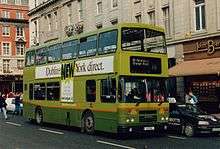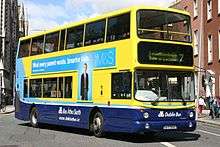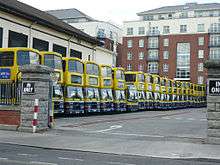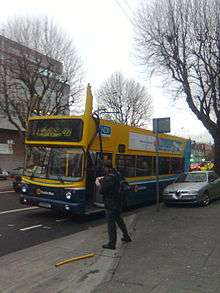Dublin Bus
 | |
|
A 2007 Volvo B9TL with Dublin Bus branding | |
| Slogan | "Serving the entire community" |
|---|---|
| Parent | Córas Iompair Éireann |
| Founded | February 2, 1987 |
| Headquarters | Upper O'Connell Street, Dublin |
| Service area | Dublin |
| Service type | Bus services |
| Routes | 110 |
| Depots | 7 |
| Fleet | 971 (July 2016) |
| Annual ridership | 122 million (2015) |
| Fuel type | Diesel |
| Chief executive | Ray Coyne |
| Website |
www |
Dublin Bus (Irish: Bus Átha Cliath) is a bus operator providing services in Dublin. It is a subsidiary of Córas Iompair Éireann.
History






Dublin Bus was established on 2 February 1987 when it was split out from the Córas Iompair Éireann.[1]
Services
Dublin Bus operates an extensive network of 110 radial, cross-city and peripheral routes and 18 night routes in the city of Dublin and the Greater Dublin Area. The company carries around 325,000 people each day.[2] The main radial routes are focused upon Dublin's sixteen Quality Bus Corridors which provide buses with daytime access to the city centre.
Express buses (branded "Xpresso") operate on similar routes, but have a limited number of stops and a higher minimum fare. These services run Monday to Friday at peak times and do not operate on public holidays.
Dublin Bus operates a "Nitelink" service of approximately 18 routes overnight which up until January 2009 ran between Monday and Saturday, with the greatest service frequency being on Friday and Saturday nights. Due to cutbacks necessitated by the economic downturn in Ireland, the midweek schedule was scrapped causing consternation with commuters. Special (higher) fares apply on Nitelink buses.
Dublin Bus also runs a Ghost Bus Tour through some of the supposedly haunted places in the city including St Kevin's Church and St Audoen's Church.[3] The tour usually runs in the evening time and includes two stops where passengers leave the bus behind and visit locations where ghosts have allegedly been seen.[4]
-

The ghostbus
In April 2010, Dublin Bus announced it would be simplifying many of its routes around the city in order to create better efficiency. This programme is called Network Direct. However, as part of these measures, the company also announced that 150 jobs would be lost.[5][6]
In 2015, the company carried 122 million passengers, which is a reduction of 16% compared to 2005 numbers (first full year of the Luas, which has seen an increase of 33.6% passengers in the same period).[7][8][9]
Route Map
Uniquely for a capital city's primary transit network, no full system-wide street map is available online. Dublin Bus cites high licensing fees from fellow state owned company, Ordnance Survey Ireland, which published a printed street map every two to five years and included bus routes. However, the latest edition, published June 2011 omits these for the first time.
Fares
Dublin Bus fares are generally calculated on a stage system based on distance travelled. There are several different levels of fares, which apply on most services. Certain routes (particularly Xpresso, see below) use a different fare system.
Dublin Bus operate an 'exact fare' policy. Passengers place the exact fare in coins (notes are not accepted) in the fare box before the ticket is issued. In the case of over payment, a "change ticket" is issued which can be exchanged at the company's head office on O'Connell Street. Routes 747 and 757, the express routes to and from Dublin Airport have a minimum fare of €6; banknotes are accepted, and change is given in cash.
There are several types of prepaid tickets available, including the following:
- Single day and multi-day tickets ("Rambler" and "Travelwide")
- Tickets corresponding to cash fares (on airport or Nitelink services)
- Travel 90 minute tickets which allow unlimited travel (or more precisely the right to board as many buses as required) for 90 minutes (available only as a ten-use smartcard)
- Tickets valid on Dublin Bus and Iarnród Éireann or Luas or all three, but tickets valid for all three systems are issued only by Iarnród Éireann.
- Leap card, a prepaid smartcard which can be used for pay as you go travel in the Dublin area. It offers discounts over standard on bus cash fares and can also be used on Iarnród Éireann and Luas services.
All of these tickets have migrated to the Leap card. This process was completed in May 2014 when all Rambler tickets, all Travel 90 and some in the Bus/Rail and Bus/Luas range were no longer available to purchase as separate smartcards. Instead, they are now loaded into the Leap card.
Prepaid tickets must be validated in a machine by the door of the bus at the start of each journey, although the validation process for leap cards differs depending on the distance being travelled.
Old age pensioners and certain other people are allowed to travel free of charge; this is part of the national "Free Travel Pass"[10] system operated by the Department of Social Protection.
Minimum fares are payable on some services to discourage passengers wishing to travel short distances from using seats that could be used by those who wish to travel longer distances.
Fleet
As of July 2016, the fleet consisted of 971 buses.[11]
Depots
Dublin Bus operate seven depots in Clontarf, Conyngham Road, Donnybrook, Harristown, Phibsborough, Ringsend and Summerhill.[11]
History & preservation
As the vehicles become of age they have been withdrawn to make way for newer technology. Types of significance such as the GAC Ireland have been preserved by the National Transport Museum of Ireland who house R1 (the first Dublin United Tramways Leyland double decker service bus in Dublin).
Many ex-CIÉ types have been acquired for preservation by private preservationists, some of whom associated with the Transport Enthusiasts Club (TEC). The vehicles are garaged, restored and run by the owners without state funds and take part in films, television programs and in vintage rallies. One event was CIE 60th. 30 October 2005 saw Dublin Bus host CIE 60th in the new Harristown depot. This event was done in co-ordination with the Transport Enthusiasts Club. Buses new and old were on display showing the contrast and how far the company had come.
.jpg)
Dublin's main bus operator was formerly the Dublin United Transport Company. This company was incorporated into CIÉ in 1945, but regained partial autonomy in 1987 when Dublin Bus was created as a wholly owned subsidiary company of CIÉ.
Accidents
Christchurch
In 1989, a youth grabbed the steering wheel of a Tallaght bound Bombardier KD bus as it turned the corner opposite Christchurch and the bus crashed onto its side. Many passengers were injured but none were injured seriously.[12][13]
Wellington Quay
On 21 February 2004, at Wellington Quay, Dublin, a bus mounted on a pavement and ploughed into a queue of 30 people, killing five and injuring 14. The driver was charged with dangerous driving, his trial began in February 2007 at Dublin Circuit Criminal Court. He has since been found not guilty of any misdoings.[14]
Bus roof damage

On 5 February 2009, a bus en route from Abbey Street to Artane collided with a tree on North Strand Road and the entire roof section was torn off. The driver was treated in hospital for shock but apart from that there were no injuries as no passengers were seated in the upper deck. The bus was an Alexander ALX400.[15]
Luas and Dublin bus crash
On 16 September 2009, a collision between a Red Line Luas tram and a number 16 Dublin Bus from Ballinteer to Santry in Dublin City Centre at the intersection of Abbey Street and O'Connell Street injured 21 people. Three people, including the Luas driver, were cut out of the wreckage. The Luas was derailed in the accident. Two female passengers remained trapped on the bus for up to 45 minutes after the crash.[16][17][18][19][20]
See also
Dublin Bus Route 46A
References
- ↑ Córas Iompair Éireann Steve Johnson's Railway Pages
- ↑ "Dublin Bus Route List". Retrieved 11 May 2013.
- ↑ "Dublin Sightseeing GhostBus Tour". Archived from the original on 26 September 2013. Retrieved 29 September 2013.
- ↑ Walsh, Dave (2008). Haunted Dublin. Dublin: Nonsuch Publishing. p. 83. ISBN 978-1-84588-932-6.
- ↑
- ↑ "9 – Dublin Bus". Dublinbus.ie. 28 August 2011. Retrieved 23 April 2012.
- ↑ Annual Report December 2015 Dublin Bus
- ↑ Annual Report December 2005 Dublin Bus
- ↑ Frequently Asked Questions Luas
- ↑ Department of Social and Family Affairs - Free Travel
- 1 2 Dublin Bus Fleet Dublin Bus
- ↑ "KD95 - 1989 Overturned 50A". Retrieved 3 March 2013.
- ↑ "RTE News Report (1989)". Retrieved 3 March 2013.
- ↑ City Guides (21 February 2007). "Irish Independent National News". The Irish Independent. Retrieved 23 April 2012.
- ↑ "Bus passengers escape injury as roof ripped off in Dublin crash – The Irish Times – Thu, Feb 05, 2009". The Irish Times. 5 February 2009. Retrieved 23 June 2009.
- ↑ "21 hurt as Luas collides with bus in Dublin – RTÉ News". Raidió Teilifís Éireann. 16 September 2009. Retrieved 23 April 2012.
- ↑ "The Irish Times – Wed, Sep 16, 2009 – Luas collides with bus in Dublin". The Irish Times. 9 September 2009. Retrieved 23 April 2012.
- ↑ 16 September 2009 – 08:15 pm (16 September 2009). "26 injured as Luas and bus collide". Irish Examiner. Retrieved 23 April 2012.
- ↑ Home & Garden (16 September 2009). "Luas tram and Dublin Bus collide in serious crash – national News, Breaking News –". The Irish Independent. Retrieved 23 April 2012.
- ↑ "Several injured as Luas tram and bus collide in Dublin | Irish News". Irish Central. 16 September 2009. Retrieved 23 April 2012.
_(8203457462).jpg)